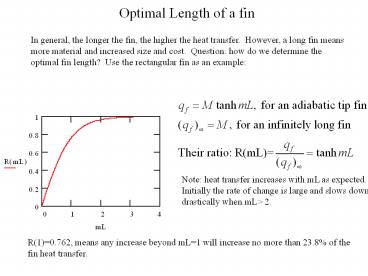Optimal Length of a fin PowerPoint PPT Presentation
Title: Optimal Length of a fin
1
Optimal Length of a fin
In general, the longer the fin, the higher the
heat transfer. However, a long fin means more
material and increased size and cost. Question
how do we determine the optimal fin length? Use
the rectangular fin as an example
Note heat transfer increases with mL as
expected. Initially the rate of change is large
and slows down drastically when mLgt 2.
R(1)0.762, means any increase beyond mL1 will
increase no more than 23.8 of the fin heat
transfer.
2
Temperature Distribution
- Use m5, and L0.2
- as an example
Low DT, poor fin heat transfer
High DT, good fin heat transfer
3
Correction Length for a Fin with a Non-adiabatic
Tip
- The correction length can be determined by using
the formula LcL(Ac/P), where Ac is the
cross-sectional area and P is the perimeter of
the fin at the tip. - Thin rectangular fin AcWt, P2(Wt)?2W, since
t ?lt W LcL(Ac/P)L(Wt/2W)L(t/2) - Cylindrical fin Ac(?/4)D2, P ?D,
LcL(Ac/P)L(D/4) - Square fin AcW2, P4W, LcL(Ac/P)L(W2/4W)L
(W/4)
PowerShow.com is a leading presentation sharing website. It has millions of presentations already uploaded and available with 1,000s more being uploaded by its users every day. Whatever your area of interest, here you’ll be able to find and view presentations you’ll love and possibly download. And, best of all, it is completely free and easy to use.
You might even have a presentation you’d like to share with others. If so, just upload it to PowerShow.com. We’ll convert it to an HTML5 slideshow that includes all the media types you’ve already added: audio, video, music, pictures, animations and transition effects. Then you can share it with your target audience as well as PowerShow.com’s millions of monthly visitors. And, again, it’s all free.
About the Developers
PowerShow.com is brought to you by CrystalGraphics, the award-winning developer and market-leading publisher of rich-media enhancement products for presentations. Our product offerings include millions of PowerPoint templates, diagrams, animated 3D characters and more.

